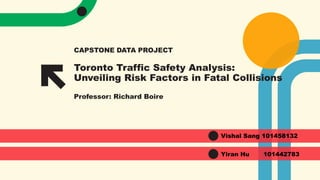
Capstone Fatal Collisions_.pptx
- 1. Toronto Traffic Safety Analysis: Unveiling Risk Factors in Fatal Collisions Professor: Richard Boire CAPSTONE DATA PROJECT Vishal Sang 101458132 Yiran Hu 101442783
- 2. Agenda Introduction 3 Approach 6 Analytical Results 13 Key Findings 20 Conclusions 21
- 3. Background Overview of the Company: • TPS mission: "To Serve and Protect." • Role in maintaining public safety and upholding the law in Toronto. • Partnership with the community for safety, law enforcement, and emergency services. • Commitment to transparency and continuous improvement. 3
- 4. Business Problem 4 • Data Overload • Public Safety • Community Engagement • Resource Allocation Key Expectations of the Client: • Insightful Analysis • Predictive Analytics • Strategic Recommendations • Community-Oriented Solutions Key Challenges of the Client:
- 5. Identification of the Problem 5 Need to effectively analyze and interpret extensive traffic collision data for enhanced public safety. Specific Challenges: • Understanding Collision Patterns • Addressing Road Safety Issues • Data-Driven Decision Making Primary Problem:
- 10. Frequency Distribution Reports • Significant occurrences on specific streets like "LAWRENCE AVE E," "FINCH AVE W," and "EGLINTON AVE E" highlight high-risk locations. • Pedestrians (517 incidents) are notably vulnerable road users in fatal collisions. • Contributing factors include speeding (187 incidents), aggressive driving (427 incidents), and alcohol involvement (44 incidents). • Temporal patterns across 846 unique dates and 629 unique times emphasize the diverse circumstances of fatal collisions.
- 11. Appendix
- 14. Selected Variables The Target Variable:'SPEEDING', because collisions involving speeding are more likely to be severe. Other Variable: TIME, INVAGE, ROAD_CLASS, TRAFFCTL, RDSFCOND, LIGHT, ALCOHOL 14
- 15. Correlation 15 ALCOHOL a positive correlation INVAGE a significant negative correlation Other a smaller negative correlation
- 16. The Exploratory Data Analysis 16 Traffic Control Certain types of traffic control are more commonly associated with collisions. 1.0 refers to No traffic Control and 5.0 refers to Traffic Signal. This shows that there were most no. of collisions in the places where traffic wasn’t being controlled.
- 17. The Exploratory Data Analysis 17 INVAGE • The age distribution shows a wide range, indicating that individuals of various ages are involved in collisions. • There appears to be a higher frequency of younger individuals involved in speeding and collisions.
- 18. The Exploratory Data Analysis 18 Road Class • The distribution across different road classes shows a varied number of collisions associated with each class. This variation can be indicative of the traffic volume, road conditions, or other factors specific to each road class that may influence the occurrence of speeding-related accidents. • 1.0 refers to Expressway Ramp • 6.0 refers to Major Arterial • Major Arterial road class have a noticeably higher count of collisions, suggesting that these classes might be more prone to accidents or have higher traffic flow.
- 19. The Exploratory Data Analysis 19 LIGHT The distribution across different light conditions shows variability in collision occurrences. 1.0 refers to Dark light Condition 4.0 refers to Day Light Conditions This Shows that most no. of Collisions happen in Day light and Dark light Conditions.
- 20. The Exploratory Data Analysis 20 Alcohol • The majority of collisions did not involve alcohol, as indicated by the higher count for '0' (No Alcohol Involvement). • However, there is still a notable number of incidents where alcohol was involved, highlighting its significance in traffic accidents.
- 21. ROC Curve 21 ROC Curve Overview: • Shows how well the model distinguishes instances with and without speeding. AUC Score Significance: • Quantifies overall model performance; higher values indicate better discrimination.
- 22. Decile/Gains Chart 22 • Reveals how accurately the model ranks instances by predicted probabilities. • Divides the dataset into deciles, showing cumulative true positive percentages for each. • Visualizes alignment between model predictions and actual instances of speeding. • Steep increases indicate the model effectively identifies a higher percentage of positive instances within subsets.
- 23. Key Findings 23 Identified influential features: TRAFFCTL and ‘ROADCLASS' play crucial roles in predicting speeding and Collision incidents. Model accuracy: Achieved an overall accuracy of approximately 77.54% on the test set. ROC Curve and AUC Score: The ROC curve and AUC score (around 0.80) demonstrate good discriminative power in distinguishing speeding incidents. Decile/Gains Chart: Indicates the model's effective ranking of instances, with a cumulative increase in true positive rate across deciles.
- 24. Conclusion • Identified influential features: ‘TRAFFCTL’ and ‘ROADCLASS.' • Suggested model refinement for improved accuracy. • Emphasized ongoing validation, ethical deployment considerations, and stakeholder collaboration for an impactful solution in predicting and preventing speeding and Collision incidents. 24
- 25. Thank you